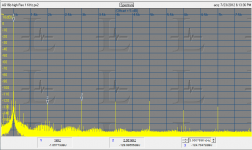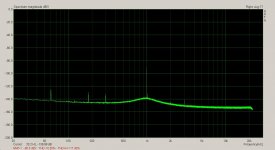Not to mention the 3 years at ft Monmouth school in communications electronics...
Thx-RNMarsh
Hi Richard,
When were you at Fort Monmouth? Eatontown, NJ is right near Holmdel, where I live. As you probably know, sadly Forth Monmouth is closed. I've been in this area since 1971. We probably both went to Atkinson and Smith for surplus parts.
Cheers,
Bob
I don't think there's much commercial potential for such equipment--Bruce Hofer knows how to design the next generation top-notch AP, and besides that there's probably no company interested in pushing the limits of audio analyzer WRT distortion resolution.
My oscillator design will be made available for DIY when I'm happy with it, just don't want to push out half-ready stuff.
Samuel
If A-P did a stripped-down version then maybe we would all just buy that.
For most of us, its just a serious hobby interest without a profit motive.
[I bought an A-P One with DSP and all options for it at $20K back when that was a lot of money
Take your time.
THx- RNMarsh
Last edited:
Hi Richard,
When were you at Fort Monmouth? Eatontown, NJ is right near Holmdel, where I live. As you probably know, sadly Forth Monmouth is closed. I've been in this area since 1971. We probably both went to Atkinson and Smith for surplus parts.
Cheers,
Bob
Hi Bob,
How did we miss each other? I was there from about 1970. A lot of important inventions were developed there. But, I spent most weekends exploring the NJ beach or up in Manhatten. I was born in Connecticut and have family all over that region.
-Richard
Last edited:
Here is a plot of my KH4400.
The KH4400 is box stock except for tweaking the second harmonic as low as I can and the addition of the external sync input (which I need to work on). It measures THD+N as -110 dB/.0003%, THD at -120 (.0001%) (400Hz-30KHz). More than good enough for most measurements.
THD at -120dB is excellant. The 725 analyzer is only 10dB better... but it is noise limited and that is what we could improve on with the best opamps available today --- if and when we can get a schematic.
Have you compared this to the e-MU 0404 which uses an AKM AK5385 and I am about to tear into it today and do the mod shown in the 0404 forum here.
What changes, if any, would your interface need to work best with the 0404?
Thx-RNMarsh
Last edited:
The app note describes doing it with the AK5394A. I don't believe anyone has implemented it with any chip. The EMU devices, the Juli@ and even RME use the AK5385, It has a distinctive rise in noise above 20 KHz. The AK5394A moves that above 100KHz with lower distortion and lower noise. I don't know who uses it in commercial products. I got a EMU0404 when I read a mistaken note indicating it had the AK5394A. It was mistake and the 0404 did not bring the anticipated performance improvement.
Demian -- Did you say the demo board for the AK5388 was expensive or was it non-existant? Was that the one you said was $400?
I'll go in 1/2 on it with anyone who wants to check its performance potential for a single or dual channel distortion analyzer. Mostly how it can be paralleled for mono performance... the chip itself is only 10 dollars at digi-key so that wouldnt break the bank for highest performance if two were used. It would be accurate to -130 and +/-10% to -140dB by the spec sheets.
Thx-RNMarsh
I'll go in 1/2 on it with anyone who wants to check its performance potential for a single or dual channel distortion analyzer. Mostly how it can be paralleled for mono performance... the chip itself is only 10 dollars at digi-key so that wouldnt break the bank for highest performance if two were used. It would be accurate to -130 and +/-10% to -140dB by the spec sheets.
Thx-RNMarsh
The EMU1212M PCI and the Lynx2 and Lynx22 do to name a couple, Lynx Two Sound Card Review . The Lynx22 is substantially less money than the Lynx2 but not cheap.The app note describes doing it with the AK5394A. I don't believe anyone has implemented it with any chip. The EMU devices, the Juli@ and even RME use the AK5385, It has a distinctive rise in noise above 20 KHz. The AK5394A moves that above 100KHz with lower distortion and lower noise. I don't know who uses it in commercial products.
I know the EMU1212M has a 5394 as I am looking at it on my bench.
Larry
Richard:
I have a demo board for the AK5394A and have wrested some pretty exceptional results. To be clear I don't think anyone has implemented the summing trick on the ADC's in commercial products. The AK5394A and AK5388 can both be used as can others. The effective equivalent is the "melt noise" synchronous averaging in the QA400. The EMU 1212 is pretty expensive and would still need revisions to get the most from.
I can lend the AK5394A board and the TI 4222 equivalent if you want. I can also provide direction on getting results. You will need something with an SPDIF in to use them and software etc. Attached is the best I have managed from it (actually it is a little better at lower levels but you bang into the noise floor pretty quickly).
I have a demo board for the AK5394A and have wrested some pretty exceptional results. To be clear I don't think anyone has implemented the summing trick on the ADC's in commercial products. The AK5394A and AK5388 can both be used as can others. The effective equivalent is the "melt noise" synchronous averaging in the QA400. The EMU 1212 is pretty expensive and would still need revisions to get the most from.
I can lend the AK5394A board and the TI 4222 equivalent if you want. I can also provide direction on getting results. You will need something with an SPDIF in to use them and software etc. Attached is the best I have managed from it (actually it is a little better at lower levels but you bang into the noise floor pretty quickly).
Attachments
Hmmmm. It seems this would be the likely next step... the parts exist but havent been tried in best fashion/form for use as a test instrument.
Now that there are several makes and models using the other AKM ADC (5385, etc) for 200-300 dollars, the next step would cost more but still a lot less than any commercial equipment.... and be SOTA test --- if we can get a generator that can supply signals that low.
Well, something to think about.... maybe just a little ahead of our time to pull this one all together. Must be getting close though. But if parts and talent exist to do it, we should. No one else will for us, that's for sure.
Thx-RNMarsh
Now that there are several makes and models using the other AKM ADC (5385, etc) for 200-300 dollars, the next step would cost more but still a lot less than any commercial equipment.... and be SOTA test --- if we can get a generator that can supply signals that low.
Well, something to think about.... maybe just a little ahead of our time to pull this one all together. Must be getting close though. But if parts and talent exist to do it, we should. No one else will for us, that's for sure.
Thx-RNMarsh
Last edited:
Here is a list of audio interfaces and the converters used:
Audio interfaces and their AD/DA chips LISTED - Gearslutz.com
Audio interfaces and their AD/DA chips LISTED - Gearslutz.com
The AK5388 is a 4channel version of the AK5394a with some features removed.
Sent from my myTouch_4G_Slide using Tapatalk 2
I thought that was a quad 5385.
Why do the individual convertors have a higher noise than a single 5394A?
I was told by AKM that the 5388 (mentioned in an app note) was essentially the same core as a 5394a. Using 4 parts on the same silicon would probably get better matching between the parts for a paralleling application like this.
The whole market for ADC's and audio interfaces has been flat for quite a few years which is why there are so few new choices.
The whole market for ADC's and audio interfaces has been flat for quite a few years which is why there are so few new choices.
Also wondering about paralleling ADC Ic's for better performance. Can that be tried without too much heart burn?
Thx-RNMarsh
At these levels everything is heart burn.
Oh by the way the SVO now extends out to 110kHz,
Here is the 1kHz now. ARTA says this is 0.000015% THD if that's possible or even believable. This is at maximum resolution 44.1ksps @ 131072 points.
More work to be done though.
Attachments
At these levels everything is heart burn.
Oh by the way the SVO now extends out to 110kHz,
Here is the 1kHz now. ARTA says this is 0.000015% THD if that's possible or even believable. This is at maximum resolution 44.1ksps @ 131072 points.
More work to be done though.
and they said it couldnt be done...
Last edited:
I was told by AKM that the 5388 (mentioned in an app note) was essentially the same core as a 5394a. Using 4 parts on the same silicon would probably get better matching between the parts for a paralleling application like this.
This would be great to try -- paralleling the 4 adc on the 5388. But, first, someone with a steady hand and good eye sight could solder a 5394 on top of an existing one to see what happens to the numbers. Who is game for that?
Thx-RNMarsh
Last edited:
- Home
- Design & Build
- Equipment & Tools
- Low-distortion Audio-range Oscillator

